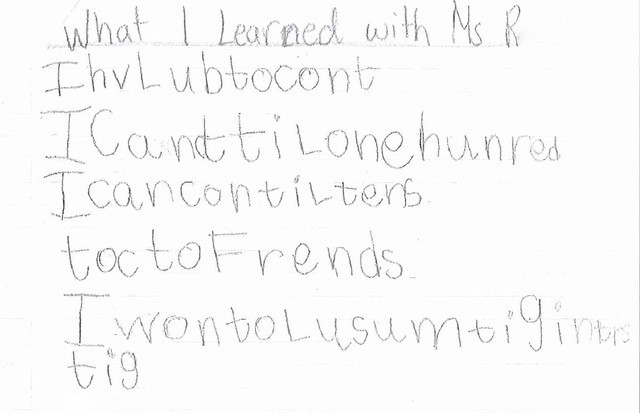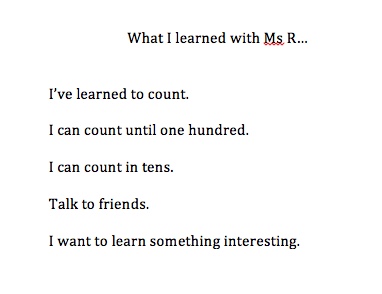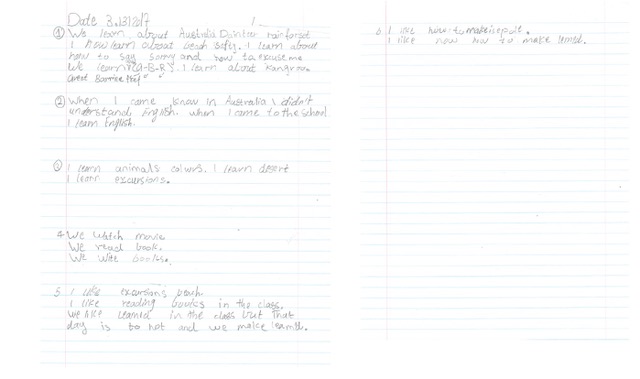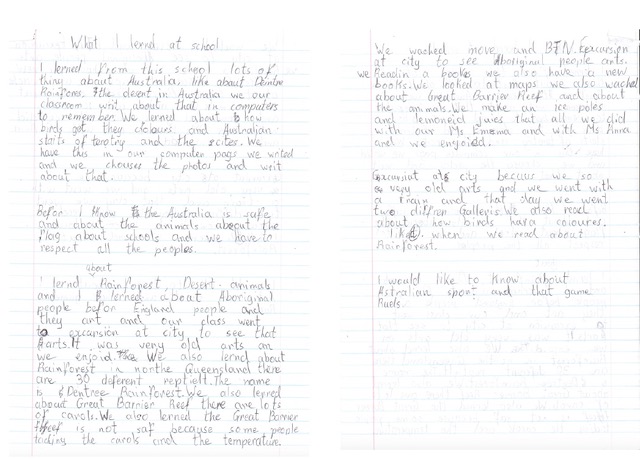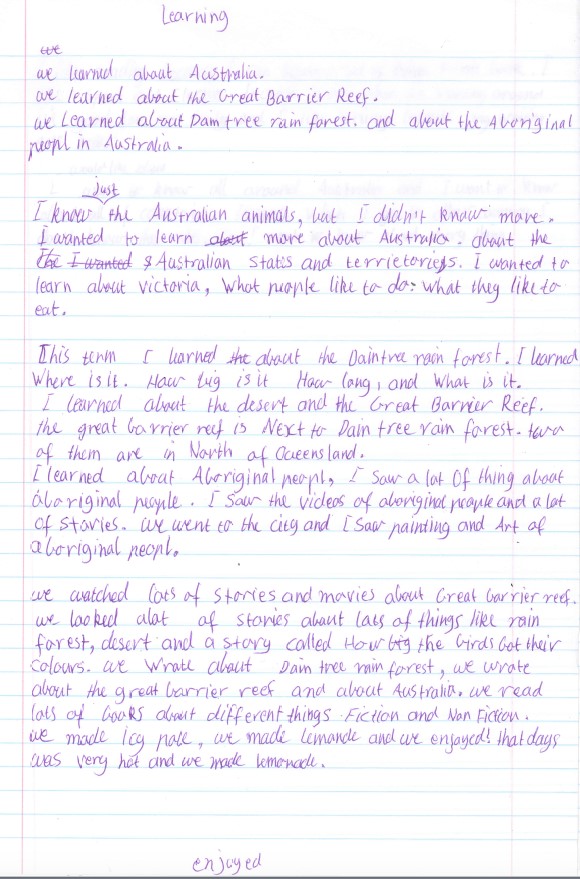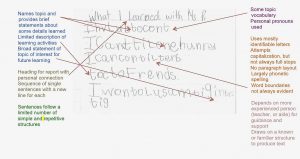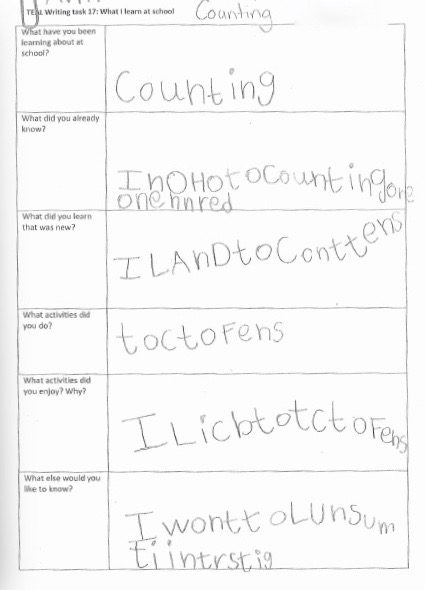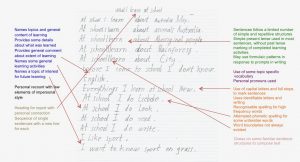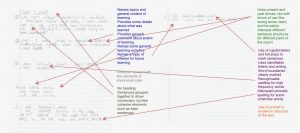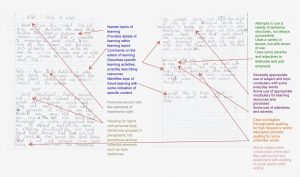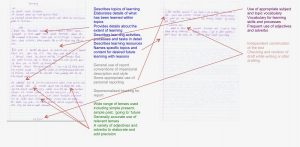17. What I learn at school
Please click on the toggles below to navigate through information on this assessment task and reveal the links for downloading task materials.
Task details |
|
| Name of writing assessment task | What I learn at school |
| EAL curriculum level range | A2, B1, B2, C1, C2 |
| Text orientation | Informative |
| Task type | Text completion |
Task specification |
|
|
Purpose
|
To assess learners’ ability to write about the activities they have recently done in school – what they have enjoyed, what they have learnt, what they are interested in learning. |
|
Description
|
Students discuss with the teacher activities they have done at school, then write about them, focusing on a recently completed unit of work or activities around a topic. |
| Assumed knowledge and description |
4. Vocabulary
|
Learning/teaching context |
|
| Language centre/mainstream class | EAL support |
| Subject/key curriculum level objectives, outcomes | English |
| Topic/teaching unit | |
| Assessment conditions |
|
|
Notes This task may not be suitable for younger Level A2 students |
|
Task implementation |
|
| STAGE | ACTION STEPS |
| Pre-assessment activity |
No specific pre-assessment activity is required, but students should have recently completed a unit of work, or a series of activities around a topic. Tell the students what they are going to be writing about, for example: We have been learning about healthy foods. I would like you to write a report to tell me about what you have learnt. You will be given some questions to help you think about what you have been learning lately. |
| Assessment activity |
Students write their own report using the prompt questions as a starting point. They can complete their writing on the prompt sheet or it can be used as a reference to guide their writing. Older students could use the prompt sheet for note taking, and then complete their writing on a separate piece of paper. Prompt questions: |
| Post-assessment activity | If students indicated that there was something they would like to learn about, help them to form a plan for investigating and doing some simple research to find out what they want to know. |
Click here to view the criteria for this assessment
TEAL Writing Task 17 – unmarked criteria sheet [PDF]
TEAL Writing Task 17 – unmarked criteria sheet [Word]
An explanation of the purpose, nature and use of criteria sheets is available at 4. Using the assessment criteria.
The nature and purpose of the task
This task is intended to assess EAL learners’ abilities to write a report about something recently learned at school. The task can relate to any area of the curriculum. As well as assessing how well students can write about a topic, they are also asked to report on their learning activities, and identify areas of interest to them in the future. The task provides an opportunity to assess the students’ skills in writing a report based on their own experience. It may be part of a broader of unit of work that helps students become more self-aware about their learning, developing skills in talking and writing about learning activities, and thinking and talking about themselves as learners.
The task can provide a context to introduce or work on the report genre. The language related to this task can be quite variable, depending on the topic being discussed. However, there are some constants, such as the use of past tense to report learning processes and what was learned. The present tense is needed when students talk about information that is generally true, or the product of learning. In the final section of the report students need to use appropriate language to talk about what helped them, their attitude to their learning activities, and what they would like to learn in the future.
This task is related to TEAL Oral Task 6: What I learn at school and TEAL Oral Task 11: Report on recent learning. The commentary on Samples 1 and 2 illustrates some strategies and issues in assessing the writing skills of students in earlier stages of developing second/additional language literacy. The commentary on Samples 3, 4 and 5 discusses how EAL learners’ writing may exhibit a higher number of errors when they are more ambitious in the meanings they attempt to convey, and raises some issues related to assessing students’ writing drafts.
Contextual information
Sample 1 was produced by a Year 2 student who was relatively new to the school. It was intended to assess the student’s general levels of English, and information about the student’s knowledge of tenses in particular. The student had been part of a class that was learning to count to one hundred in tens, using concrete materials such as Unifix blocks and other objects to provide a concrete foundation for the learning. The teacher scaffolded the task with a conversation about what the student had been learning, and this was used as a basis for the student to complete the prompt questions after the student answered the questions verbally. In a subsequent lesson, the completed worksheet was used to provide the basis for the student to write Sample 1.
Samples 2 to 5 were produced by students in a class in a new arrivals English language school. Students in the class were at different stages of proficiency within Levels C1 and C2, Victorian Curriculum F-10 EAL. The whole class sat together at the board and the teacher used Google Translate to translate the prompt questions into the languages spoken by students in the class. The students read the translations and scribed these in their first language on the question sheet, to ensure deep understanding of the questions and the writing task.
There was a whole-class discussion to create a class mind map on the white board. Most students in the class offered suggestions, and some offered more than others. The class then broke into two groups to write their reports. The students at lower levels of EAL proficiency worked with a literacy aide and were very dependent on the vocabulary written on the board, and chose to work very much within a familiar sentence structure. A student in this group produced Sample 2. The more proficient students worked independently at the same time to produce their own reports, and students in this class group produced Samples 3, 4 and 5.
Commentary
General commentary
These samples illustrate some aspects of assessment of EAL learners in both the early stages of developing proficiency in English, and learning either initial literacy skills, or coming to terms with a new or relatively unfamiliar script at the same time. Both Samples 1 and 2 were the result of strong scaffolding provided to their writers, but despite this, inexperienced or unsympathetic readers would see these texts as either barely comprehensible or not adequate responses to the task. However, both samples demonstrate considerable learning by their authors. Samples 3, 4 and 5, were produced more autonomously. They illustrate how apparently basic errors may occur when students are more ambitious about the meanings they want to convey. A focus on the number of errors in such texts can lead to underestimation of what an EAL student has achieved, and the way they are progressing. As they make progress in learning, EAL students may draw on understandings from their first language and try to convey more complex meanings. This places greater demands on their language knowledge and they need to utilise more complex grammar. The result can be a deterioration of sentence and phrase structures and syntax. The sequence of these samples shows how important it is to carefully analyse EAL students’ writing across a number of dimensions, and avoid the temptation to see errors only as signs of deficiency or limited language skills.
Samples 3, 4 and 5 are first drafts that were produced quite independently by their authors, and have not been revised or self-checked for final presentation. Errors in these samples may reflect the students’ focus on communicating ideas at the drafting stage. It is important to understand the process that has led to the production of an EAL student’s text. A text produced as a first draft can provide insight into the types of errors learners may make while focusing on the meanings they wish to convey, or writing under pressure, but may not show what the student can do when given the chance (or even explicit direction) to correct their draft for grammatical and other language errors. The TEAL writing observation sheet can assist teachers in understanding the strategies and focus of EAL learners as they produce written texts
This sample is readable for a sympathetic and experienced reader who knows something of the context in which it was produced. However, a more detached and less sympathetic reader of the text would have difficulty in understanding it without some explanation, such as the transcription provided. However, what may appear difficult to recognise to a less experienced or empathetic reader actually shows the student is beginning to work with the phonetic basis of English writing and spelling, even though the child has not yet learned the correct form of many of the words used in the report, including key vocabulary for the topic of counting.
The sample suggests the student understands the task and is reporting her or his personal experience in a series of sentences that respond to the scaffolding provided on the task sheet. The student uses appropriate subject-verb-object grammar following the sentence beginnings such as I have learned.. (written as IhvLub..) and I can.. (written as Ican..), except in the sentence about what they did to learn, which has no subject (written toctoFrends). It is not clear whether the second sentence is intended to be I can count to one hundred, or I can count til one hundred, and Sentence 3 looks like til tens, which may suggest the student is confused about the use of until or til, or does not know how to spell in tens. The intended vocabulary is generally appropriate, despite the unconventional spelling. The attempted phonetic spelling indicates the student is making progress in understanding sound-symbol relationships in written English, and most words are recognisable, hv for have, Lub for learned, cont for count, and hunred for hundred. The student makes a good attempt at intrstig (interesting). The student seems to be developing knowledge of the sound value of consonants, particularly at the beginning and ends of syllables and words. While letters are generally well-formed and legible, lower case l and f are written as upper case, and lower case g is placed too high on the line. Capital letters are usually used at the beginning of sentences, but full stops are not used, and there are no spaces between words.
While written language is often a better way than speaking to ascertain how an EAL student’s control over grammatical structures is developing, the spelling problems of this text makes it difficult to comment on the student’s use of tenses here. We can’t be certain whether toc is an attempt to write talk (present tense) or talked (past tense).
It is interesting to compare what the student wrote on the worksheet and the final written text. In some ways, the final text shows improvements on the worksheet (friends written as Frends rather fens), but in others, the final text is arguably not as language-rich as the worksheet text, for example Inohotocountingoneonehnred [I know how to counting one hundred] becomes Icanttilonehunred [I can count to one hundred] and the verb phrase I know how to… isn’t used in the final text. This illustrates how teachers can obtain a more complete understanding of student’s development, as well as the recursive nature of students’ language development, by looking at more than one piece of an EAL learner’s writing .
The marked criteria sheet shows that the student meets most criteria at level 1 of performance.
The student’s language use in this task is consistent with the descriptions of students at Level A1, Victorian Curriculum F-10 EAL
TEAL Writing Task 17 – criteria sheet – Sample 1
Using the assessment for further learning
The following teaching priorities emerge from analysis of this text:
- Spelling of high frequency and key content words
The student is making progress in learning to write English words, but will benefit form a focus on the accurate written form of some of the key content words of the topic, such as count and hundred, and high frequency words such as friends, in and something.
- Ask the student to read the text aloud to you.
- When you reach one of the target words, ask the student to pause after reading the word.
- Point out that this word isn’t written correctly, and write the correct spelling on a sheet of paper.
- When the student completes reading the text, point to the words you have written, and ask the student to find where they have tried to write this word in their text.
- Ask the student to look at the correct spelling, and rewrite the word in their text, using the correct spelling. If necessary, the student could rewrite the whole sentence.
- Leaving spaces between words
While the student is writing on the lines and with legible letters, the lack of spaces between words makes the text hard to read.
- Remind the student about the need to leave spaces between words, so readers can clearly see the different words.
- Ask the student to read a sentence to you. After they read it, ask them to use a pencil to make a vertical line in the places where there are or should be spaces between the words.
- When the student has identified the locations of word boundaries in the sentence, ask them to rewrite the sentence, but making sure there are spaces between each word (where they put the vertical lines). Suggest the student use two fingers, or some other concrete measure, such as a sufficiently wide building block, to show them where the gap should be between the words.
- Do this for as many sentences as possible within the student’s concentration span.
- Formation of lower case l, f and g
While most letters are formed clearly, the student is still making consistent errors with these three letters, so attention to these is warranted.
- Point to where the student has used a lower case c, and where they have written an upper case C. Either ask them to explain or name the difference between these two forms of the letter C, or remind them of the difference between upper and lower case letters.
- Ask the student if they can remember the difference between upper and lower case for the letter l. Show them the two forms of L if they can’t show you.
- Point to where the student has written upper case L in the heading, and point out this should be a lower case letter, and should be corrected.
- Ask the student to find other examples of where lower case l should replace what was written, and correct them.
- After all the ls are corrected, ask the student to look for any other letters that might need similar correction. If necessary point to F in Friends and C in Count.
• Finally point to the letter g in something. Model how it should be written, with the tail below the line, and ask the student to correct the letter in this word, and also in the next word, interesting.
Sample 2
While the text provides comprehensible information, it is repetitive, and is a series of individual sentences rather than a cohesive report. These sentences rely on familiar sentence patterns, At school I learn…. and At school I do…, with attempts at variation with errors where variations were attempted (lack of capitalisation in before I come to this school… and omission of a verb in the sentence beginning Everythings I learn… . The final two sentences use other simple patterns more successfully I like… and I want to know..., which may be formulaically produced by responding to the worksheet.
While the text conveys content as a report of personal learning, it is written entirely in the present tense, when past tense is required in this context for learning that is complete (I learned..), and for learning activities (we wrote). There is overuse of the auxiliary verb do in the sentences reporting on learning activities, and the only expression of an attitude to these activities is a generic statement I like sport, which is not connected to specific learning activities.
Other grammatical errors include a lack of articles the City, omission of the preposition about sport on grass (although about is successfully used in the first five sentences), using Australia for Australian as an adjective with animals, but placing it after the noun. A similar structure is used before the noun, Australia map, when map of Australia would be more appropriate. While some subject-specific vocabulary is used successfully, such as animals and Aboriginal, there are spelling errors with some words, such as Rainforesg, icebole (for icy pole), and the meaning of sport on grass is not clear.
The writing is generally recognisable, apart from insufficient space between some words in sentences 3, 4 and 5. Sentences are usually marked with initial capital letters and final full stops, but there is some inappropriate capitalisation of words, Map, City, Rainforesg, New and Look.
The teacher reported that this student worked in the group of students who worked with the assistance of a teacher aide who spoke the student’s first language, and was heavily dependent on words written on the board and a simple subject-verb-object pattern to form sentences. This sample illustrates how students who are new to English, and relatively new to Roman script, have to concentrate on fundamentals of letter formation and layout, as well as basic structures of the language, and are likely to have a limited language repertoire in formal writing tasks in the early stages of second/additional language learning.
The marked criteria sheet shows that the student meets most criteria at levels 1 and 2 of performance of this task.
The student’s language use in this task is consistent with the descriptions of students at Level C1, Victorian Curriculum F-10 EAL.
TEAL Writing Task 17 – criteria sheet – Sample 2
Using the assessment for further learning
The following teaching priorities emerge from analysis of this text:
- Review correct and incorrect use of capital letters
Incorrect use of capital letters is a distraction to the reader.
- Remind the student that capital letters are only used to begin sentences, and for the names of people and places, and that all other words should begin with lower case letters.
- Ask the student to check what they wrote, and check they used capital letters correctly. Ask the student to circle where she or he thinks they have made a mistake in the use of capitals. Check the student does this accurately, and point out any errors they have missed.
- Ask the student to write the correct form of the letter above the circles they have drawn.
- Ask the student to use the corrected form of the letter when they re-write the text or sentence, such as in the following teaching activities.
- Spelling of subject vocabulary
While not a major issue in the comprehension of the text, spelling errors made by the student suggests that correction now will help them to remember the correct spelling of the words.
- Ask the student to point out any words they think are incorrectly spelt, or that they are not sure about. Give feedback on the words they mark, and make sure rainforest and icy pole are included in what the student has marked. Invite the student to correct the spelling themselves, but model correct spelling of any words the student is unable to correct.
- Ask the student to write the words correctly, to replace their incorrect spelling in their text.
- Remind the student to use correct spelling of these words when they re-write the text.
- Paragraph formation
A significant step for this student would be to begin to write in paragraphs, rather than listing sentences one after the other. However, as the student still needs considerable scaffolding with their writing, this may be best done through provision of a template to help the student group sentences into paragraphs.
- Show the student an example of a report, written in paragraphs. Point out how sentences are grouped together, both in layout, and around a central theme or idea, such as, for example, what topics we have learned at school, the details for what we learnt, the things we did to learn, and what we would like to learn in the future.
- Ask the student to point out how her or his presentation of the report looks different. If necessary point out the listing of the sentences in their text, rather than sentences being grouped in paragraphs.
- Give the student a template like the one below. Explain it to the student, and ask the student to use it to help them to re-write their report, using their original ideas, but fitting them into the paragraph structure of the handout, using the sentence beginnings provided to begin each paragraph.
- Show the student how to use commas and conjunctions, such as and, to connect sentences on the same subject. For example: At school I have learned about Australia, the city, and making icy poles.
If the student is ready, also show how an alternative structure I have also learned…. Can be used to make the sentences less repetitive.
- Work through the first paragraph to produce a model, and then ask the student to do the same thing for paragraph 2. Ask the student say what they plan to write, so you can check their understanding of what is expected before they begin to write.
- Monitor the student to ensure instructions are followed, and ask he or she to complete the final two paragraphs.
- If appropriate and time permits, ask the student to use the template to write a new text, following what they have done on the template, in their workbook, following the paragraph layout.
| Heading : | ||
| Paragraph 1 | Main idea: Topics I have recently learned about at school | At school I have learned about …..…, ……… and ……….. . |
| Paragraph 2 | Main idea: Things I have learned. | I learned that …………………. and ……….. . I also learned……. . |
| Paragraph 3 | Main idea: The things we did to help us learn. | We ………….., ……………, and ………….. to help us to learn. We also….. …………, and ………… . |
| Paragraph 4 | Main idea: some things I would like to learn. | I would like to learn about ……, ………… and ………… . |
Sample 3
This sample is a more successful report in some respects, as it attempts to use a paragraph structure rather than presenting a list of sentences. However, it has limited success. The text reports only very general learning activities, and has some noticeable weaknesses. Numbering as well as spacing is used to mark each paragraph, and while paragraphs 1 and 2 have some structure as connected sentences, paragraphs 3, 4, 5 and 6 revert to the listing of sentences. While there is limited use of past tense, e.g. came, didn’t understand, present tense is mostly used for actions that should be written in past tense. This is especially noticeable in the first and third paragraphs referring to what was learned, and paragraph 4 and 5 referring to learning activities.
There is some variety in the sentence structures used, including some attempts at compound sentences, I learn how to say sorry and how ta excuse me, though paragraphs 3 and 4 use only simple and repetitive sentences e.g. We watch movie… We read book. The meaning of some sentences is not clear, as in When I came know in Australia I didn’t understand English,… We like learned in the class but that day it was too hot and we make leamed… [lemonade].
The sample uses a reasonable range of topic vocabulary such as beach safety, kangaroo, Great Barrier Reef (abbreviating this as G.B.R. in one place) desert and excursions. There are spelling errors, such as Dainteer for Daintree, safty for safety, kangroo for kangaroos, wite for write, icepole for icy pole, and leamd and lemed for lemonade. Some phrases are not properly formed, such as Australia Dainteer rainforest, learn excursions, and there is some inconsistency where in one place a word is correct, and in another place it is incorrect, such as how to once in paragraph 1 and also as how ta a few words later.
Letters are generally legible, despite some problems, such as colwrs in paragraph 3, and some inconsistency of angle of slope in letters like l, d and b. The contrast between some upper and lower case letters is not as clear is it could be, such as I now learn in paragraph 1, and We watch in paragraph 4, and an incorrect That day in paragraph 5. There are punctuation problems with the attempted abbreviation of Great Barrier Reef in paragraph 1, and quotation marks are not used for expressions being described as learned, e.g. ‘Sorry’ and ‘Excuse me’.
This sample illustrates how a greater number of errors can occur as a student tries to be more ambitious and convey greater meaning or use relatively new structures, in this case paragraph layout in a text. It also seems that the student may have rushed parts of the text, and/or not checked over it after completing the draft.
The marked criteria sheet shows that the student meets most criteria at levels 2 of performance of this task.
The student’s language use in this task is consistent with the descriptions of students at Level C1, Victorian Curriculum F-10 EAL.
TEAL Writing Task 17 – criteria sheet – Sample 3
Using the assessment for further learning
The following priorities emerge from analysis of this text:
- Consistent us of past tense for completed actions in the past (learning and learning activities)
The student demonstrates some awareness of past tense, but is not yet using it when it is expected.
- Remind the student that past tense should be used for actions. See if the student can point to where they have used it appropriately.
- Then ask the student to point out where it should be used, and to name and write the correct form of the past tense that should be written. Monitor, and provide feedback about correct forms when necessary.
- Ask the student to use these when they re-write the text.
- Spelling of words
The student makes many spelling errors, although many of the attempted spellings suggest the student is developing awareness of the sound-symbol relationships of English.
- Comment that the text contains spelling errors. Ask the student to mark or circle words they think are incorrectly spelt, or which they are unsure about. Draw attention to incorrect spelling the student misses.
- Work through the marked words with the student, and ask the student how they think they word is spelt. Give feedback and where necessary model the correct spelling.
- Ask the student to use the correct spelling of these words when they re-write the text.
- Paragraph formation
The student is aware of the need to use paragraphs in a report, but has inappropriately used numbers, and listed single sentences in paragraphs 3, 4, 5 and 6.
- Show the student an example of a report written in paragraphs. Point out how sentences are grouped together, both in layout, and around a central theme or idea, such as what topics we have learned at school, the details for what we learnt, the things we did to learn, and what we would like to learn in the future.
- Tell the student that she or he has done this well in paragraphs 1 and 2. Ask the student to comment on the paragraphs that follow. Point out the listing of the sentences if necessary. Also point out that numbers should not be used, rather that paragraphs should be formatted with indentation of the beginning of the first sentence.
- Give the student a template like the one below. Explain it to the student, and ask the student to use it to help re-write their report, writing full paragraphs 3, 4, 5 and 6 using their original ideas, but fitting them into the paragraph structure of the template, and using the sentence beginnings to begin each paragraph.
- It may be necessary to show the student how to use commas and conjunctions such as and to connect sentences on the same subject, such as: I watched movies and read books or I also learned….
- Monitor the student to ensure they are doing what is expected and ask them to complete the final paragraphs.
| Heading : | ||
| Paragraph 1 | Main idea: Topics I have recently learned about at school | At school I have learned about …..…, ……… and ……….. . |
| Paragraph 2 | Main idea: Things I have learned. | I learned that …………………. and ……….. . I also learned……. . |
| Paragraph 3 | Main idea: The things we did to help us learn. | We ………….., ……………, and ………….. to help us to learn. We also….. …………, and ………… . |
| Paragraph 4 | Main idea: some things I would like to learn. | I would like to learn about ……, ………… and ………… . |
Sample 4
This sample shows greater understanding of the report genre and has a relatively sophisticated structure, including description of learning, learning activities and comments about these. It uses coherent and appropriate paragraph structure and conveys the student’s intended meaning to the reader. However, there are extensive problems of sentence structure and misspelling of content and high-frequency words that detract from the quality and authority of this text as a piece of formal writing.
The first paragraph attempts to provide an overview of what follows, including content of learning, learning processes and how activities aided learning, our classroom writ about that in computers to remember. The following paragraphs provide a flow of information, beginning with a statement about what the student knew about Australia prior to learning about it at school, followed by description of what was learned in detail, learning activities (although there are problems with how paragraphs 4 and 5 are constructed and relate to each other), and finishing with a statement about what the student would still like to learn.
The student attempts to use a range of sentence types, but this results in some serious problems of construction, with some run-on sentences (where one idea runs into another without adequate breaks), punctuation marking or linking devices, such as conjunctions. An example is the single sentence that makes up paragraph 2. The first sentence of paragraph 5 seems to be an attempt to answer the question on the prompt sheet, producing a sentence with an incomplete subject.
There is some use of past tense, despite problems with spelling, such as lernd, wached and so (for saw). The student seems confused over the correct past tense for the verb write, and uses writed for wrote, in paragraph 1. This suggests that the student is trying to use past tense but is not aware of the irregular past participle, wrote. Writ is also used, but it is unclear whether the student was making a tense error with incorrect spelling and attempting write, rather than wrote. Correct past tenses are attempted in some places; lernd (although spelt incorrectly throughout) wached (watched), looked, went, did, enjoied (enjoyed), but not in others places where have, know, reading, and make are used when they should be past tense. The student seems to have awareness of the use of past tense, and added the final letter to like in paragraph 5, even if she or he is not sure whether it should be d or t.
There are frequent spelling errors. Some of these have phonetic quality, suggesting the student is starting to understand sound-symbol relationships in English while not knowing the conventional spelling of some words relevant to the topics of learning, e.g. lerned for learned, staits for states, chouses for chooses (chose), defferent for different, saf for safe, taching for touchin, terotry for territory, lemoneid for lemonade and Galleris for galleries. Some spelling errors seem to reflect some visual confusion about the sequence of letters, carol for coral, reptielt for reptile and move for movie. These are more problematic in terms conveying meaning.
Some adverbs, such as also, which is used extensively, and very, are used to connect and expand ideas. About is used extensively, especially in conjunction with know, and other prepositions such as when and with are used appropriately. However, there are some errors in the use of prepositions in the second last paragraph, such as at city (used twice), and we went two different Galleris, which could be either confusion of spelling (intended meaning we went to different galleries), or omission of to (intended meaning we went to two different galleries).
The hand writing is quite clear, with good letter formation and appropriate punctuation, despite some crossing out and correction, suggesting that the student either monitored her or his language while writing, or did some revision of the text after completing the draft.
The marked criteria sheet shows that the student meets most criteria at level 3 of performance of this task, with some at level 2.
The student’s language use in this task is consistent with the descriptions of students at Level C1, Victorian Curriculum F-10 EAL.
TEAL Writing Task 17 – criteria sheet – Sample 4
Using the assessment for further learning
The following priorities emerge from analysis of this text:
- Sentence formation
Despite quite good text structure, sentences are often not well formed or clearly marked, and often include too much information.
- Remind the student that sentences in a report should contain a clear idea or piece of information, and should begin with a capital letter and end with a full stop. Remind the student that the main idea of the sentence should be very clear to the reader, and the subject and main verb should be very obvious. Make the point that it is better to have short but clear sentences, than to have long and complicated sentences.
- Ask the student to look at paragraph 1, and identify the first sentence. Read it and ask the student if it seems all right. You might suggest it could be improved by moving lots of things forward to before from this school, omitting about and adding the before Daintree forest, and and before the desert.
- Ask the student to check the next sentence. Draw attention to the subject and the verb, and that how In our classroom would be a good way to begin the sentence. Remind the student to check the punctuation.
- Work through the other sentences in the first paragraph and suggest improvements.
- Ask the student to review all the sentences in the following paragraphs and make necessary changes.
- Review what the student does and provide feedback on improvements and sentences still needing improvement.
- Spelling
There are frequent spelling errors, but many of these have phonetic quality, and so it is worth having the student pay attention to the conventional spelling of words spelt incorrectly.
- Make a list of the words spelt incorrectly by the student, using the correct spelling.
- Show this to the student, and ask the student to find these words in the text and rewrite them so they are correct.
- Prepositions
While the student used a range of prepositions well, there are some noticeable preposition errors in the second last paragraph.
- Compliment the student on her or his use of prepositions, which can be a difficult area of the language to learn. However, point out that the second last paragraph has a few errors with this type of word.
- Ask the student to check the following expressions from that paragraph, and ask if they can choose a word from the second row to replace the words in bold:
Excursion at city we went with train we went two different galleries
by on along to in under over from
Sample 5
Although the first paragraph is a short list of basic and not properly punctuated sentences, the rest of the text shows considerable sophistication in terms of the style of report expected in this task. Paragraph 2 goes on to convey the limitations of the student’s knowledge prior to learning, followed by paragraph 3, which presents a detailed statement of what was learned. Paragraph 4 provides a detailed description of learning activities, and paragraph 5 clearly describes an area of learning the student enjoys, and the reasons he or she enjoys it. The text concludes with a clear (and broad) statement about what the student would like to learn, and a statement of the reasons for the choice. However, despite the strengths of the structure and content of the report, there are many noticeable errors of sentence construction, spelling and punctuation.
Some sentences are very short and have a simple structure, such as the sentences in paragraph 1. However, there are more complex sentence structures in the following paragraphs, containing errors of structure and punctuation. These result from the student attempting to say more and make stronger connections between different sentences. For example This term I learned about the Daintree rain forest. I learned where is it. How big is How long, and What is it. While this collection of sentences seems at first glance to exhibit errors of punctuation (missing full stops, questions with no question marks, inappropriate capitalisation, and incorrect question structures), the student seems to be attempting a complex listing sentence that could read: This term I learned about the Daintree rainforest, including where it is, how big it is, how long it is and what it is. The student stumbles on transforming questions into statements, but seems to be trying to combine a number of related ideas into a single, more interesting sentence, rather than producing short repetitive sentences. The student uses a number of list-like sentences, in paragraph 2 (with reference to learning about Victoria), paragraph 4 (with reference to reading both fiction and non-fiction), and other places uses conjunctions and or but to connect ideas and construct longer sentences.
As the text goes on the student not only says what she or he has learned, but gives details and says why it was important or interesting, attempting to make a more elaborate and more interesting text. This is more successful in sentences like We watched lots of stories about lots of things like rain forest, desert and a story called How the Birds Got their Colours (although the repetition of lots of, is distracting). The student generally uses past tense in describing what was learned and done, and present tense for content of learning. Attitudes to learning activities and reasons are given for personal reactions to experiences.
A range of topic vocabulary is used, mostly accurately, despite some spelling mistakes, such as terrietories for territories, peopl for people (although this is correctly spelt a few words later). The definite article, the, is used appropriately for geographical features such as the Great Barrier Reef, but omitted for Daintree rainforest, and correctly omitted when it should be, as with Victoria. There are quite a few errors of punctuation, with capital letters not used when they should be at the beginning of sentences, and one instance of great barrier reef, where no capital letters are used, and when capitals are used inappropriately, such as Fiction and Non Fiction (paragraph 4) and Elective (paragraph 5). Full stops are overused in places, and sometimes used like commas, perhaps reflecting the way the student is attempting to list information in parts of the text.
There is some evidence of strategies used by the student while writing the text. The insertion of just in paragraph 2, and would like ….about .. in paragraph 6, the insertion of would like and then about appear to be the result of review of what was written, as well as enjoyed being written at the bottom of page 1, suggesting the student may have wanted to check the word or its spelling while writing the text.
The marked criteria sheet shows that the student meets many criteria at level 4 and some at level 3 of performance of this task.
The student’s language use in this task is consistent with the descriptions of students at Level C2, Victorian Curriculum F-10 EAL.
TEAL Writing Task 17 – criteria sheet – Sample 5
Using the assessment for further learning
The following priorities emerge from analysis of this text:
- Listing sentences
The student makes errors when attempting to write listing sentences in several places in the text.
- Point out the list that is presented as the first paragraph, and that sentences providing several pieces of information are often needed in reports.
- Point out that these sentences all begin with we learned and so are about the same topic, and so could belong in a single sentence. Explain that there are ways of putting that information in a single sentence. It’s a little bit like making a list, so we can call these listing sentences.
- Show the student some model listing sentences, such as these. Emphasise the sentence openings, the verb include, the use of commas, the joining conjunctions (and, as well as) and the adverb (also) showing how they link different items together:
| Listing sentences | |
| Opening or topic sentences |
At school we learned about Australia, the Great Barrier Reef, and the Daintree rainforest. Topics we have studied at school recently include the map of Australia, the Great Barrier Reef and the Daintree Rainforest. |
| Following sentences | We also learned about Aboriginal people, the main cities and the different states and territories.We learned about Aboriginal people and the main cities as well as the states and territories. |
- Ask the student to review their report, and circle groups of words or sentences, where the student thinks a listing sentence could be used.
- Ask the student to write a listing sentence they could use on each of the places they have circled.
2. Writing an engaging introductory paragraph
The first paragraph does not match the quality of the subsequent paragraphs, and appears to be a list of notes to help the student to begin writing.
- Point out how the first paragraph does not match the structure or interest of the other paragraphs in the text.
- Ask the student to re-write the first paragraph so that it is more interesting, and more like the other paragraphs. Suggest the student consider the linking sentence(s) they wrote for the previous exercise.
3. Reviewing and checking strategies
There is evidence the student has reviewed the draft when it was completed, and wrote words outside the text to check the spelling. However, the checking has not picked up some inconsistencies and problems in the text.
- Ask the student about how they checked or reviewed the text when it was completed. Compliment them on the evidence you can see.
- But point out some things that were missed, including spelling errors, some errors with capital letters and punctuation.
- Ask the student to re-check their text, but to do this several times, looking for one aspect of language use at a time. Suggest this sequence:
- sentence structure and punctuation
- the use of capital letters
- spelling.
A possible follow up is to ask the student how well this worked, compared to a single review trying to find everything at once.
